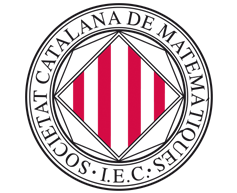Organisers: Albert Mas (UPC) and Luís Vega (BCAM and UPV / EHU)
Friday Oct 23, 15:35 – 17:45, Zoom room Prat de la Riba 2
15:35 – 16:15 – Alberto Enciso (ICMAT, CSIC)
The Gross–Pitaevskii equation is a nonlinear Schrödinger equation that models the behavior of a Bose-Einstein condensate. The quantum vortices of the condensate are defined by the zero set of the wave function at time t. In this talk we will present recent work about how these quantum vortices can break and reconnect in arbitrarily complicated ways. As observed in the physics literature, the distance between the vortices near the breakdown time, say t=0, scales like the square root of t: it is the so-called t^1/2 law. At the heart of the proof lies a remarkable global approximation property for the linear Schrödinger equation. The talk is based on joint work with Daniel Peralta-Salas.
16:20 – 17:00 – Pedro Caro (BCAM)
In this talk I will present some recent results —obtained in collaboration with Andoni García— on point-source scattering theory in the presence of critically-singular and delta-shell potentials. These potentials consist of a combination of compactly supported functions with local singularities in the critical Lebesgue space and measures supported on compact hypersurfaces. To address the forward and inverse problems, I will show some new spaces adapted to the resolvent operator. These spaces turn to be very convenient to treat such potentials, and we hope that they could also help to deal with more singular perturbations.
17:05 – 17:45 – Tadahiro Oh (U. Edinburgh)
In this talk, I will go over recent developments on well-posedness theory of stochastic nonlinear wave equations (with random initial data and/or forcing) and their associated invariant measures in two- and three-dimensional settings.
Saturday Oct 24, 10:30 – 12:40, Zoom room Prat de la Riba 2
10:30 – 11:10 – Xavier Tolsa (ICREA – UAB)
In a work from 1991 Fang-Hua Lin asked the following question. Let Ω⊂ℝ^n be a Lipschitz domain. Let u be a function harmonic in Ω and continuous in Ω which vanishes in a relatively open subset Σ⊂∂Ω and moreover assume that the normal derivative ∂_ν u vanishes in a subset of Σ with positive surface measure. Is it true that then u is identically zero? Up to now, the answer was known to be positive for C^1-Dini domains by results of Adolfsson-Escauriaza (1997) and Kukavica-Nyström (1998). In this talk I will explain a recent work where I show that the result also holds for Lipschitz domains with small Lipschitz constant, and thus in particular for general C^1 domains.
11:15 – 11:55 – Xavier Fernández-Real (EPFL)
The fractional obstacle problem in ℝ^n with obstacle φ∈ C^∞(ℝ^n) can be written as
min{(-Δ)^s u , u-φ} = 0, in ℝ^n.
The set {u = φ}⊂ℝ^n is called the contact set, and its boundary is the free boundary, an unknown of the problem. The free boundary for the fractional obstacle problem can be divided between two subsets: regular points (around which the free boundary is smooth, and is n-1 dimensional) and degenerate points. The set of degenerate points, even for smooth obstacles, can be very large (for example, with infinite ℋ^n-1 measure). In a joint work with X. Ros-Oton we show, however, that generically solutions to the fractional obstacle problem have a lower dimensional degenerate set. That is, for almost every solution (in an appropriate sense), the set of degenerate points is lower dimensional.
12:00 – 12:40 – Luis Vega (BCAM – UPV/EHU)
We make a connection between a famous analytical object introduced in the 1860s by Riemann, as well as some variants of it, and a nonlinear geometric PDE, the binormal curvature flow. As a consequence this analytical object has a non-obvious non- linear geometric interpretation. We recall that the binormal flow is a standard model for the evolution of vortex filaments. We prove the existence of solutions of the binormal flow with smooth trajectories that are as close as desired to curves with a multifractal behavior. Finally, we show that this behavior falls within the multifractal formalism of Frisch and Parisi, which is conjectured to govern turbulent fluids. This is a joint work with Valeria Banica.
